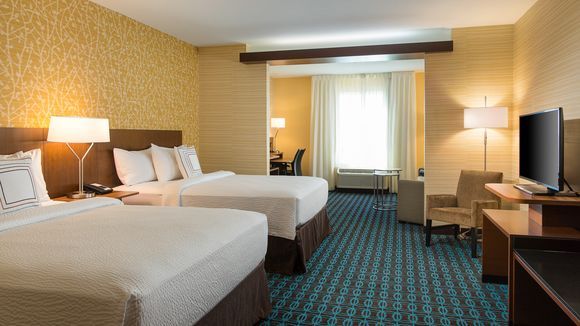Marriott International, the largest hotel company in the world, is betting big on modular construction to drive its growth in North America.
The Bethesda, Md.-based company expects to sign 50 hotel deals this year that would incorporate prefabricated guestrooms and/or bathrooms. That would make up about 13% of signings for North America this year.
The construction process works like this: Guestrooms and bathrooms are built away from the site of the hotel in a climate-controlled factory. Once completed, the units are transported to the site, where the base and frame of the property have been built.
The units get stacked into place by crane. Workers then complete the electrical and plumbing systems and finish other details.
Marriott has opened one hotel using this method: the 97-room Folsom Fairfield Inn and Suites in Folsom, Calif.
The units contained two rooms that included a bed, desk and toilet, plus a connecting corridor. The project was finished two months ahead of time.
“The reason Marriott and others are embracing the modular construction process is that it can dramatically shorten the overall construction schedule, which leads to quicker occupancy and quicker return on investment,” says Tom Hardiman, executive director of the Modular Building Institute, a non-profit trade association.
Some of the challenges hotels can avoid using this process are skilled labor shortages and poor weather.
The hotel industry in the USA has been slower to adopt this method than it has in Europe, where labor costs are higher and warrant alternative forms of construction.
Overall, about 3% of all construction starts use modular construction in North America, Hardiman says. The percentage is historically lower in the hotel construction sector, but he expects that to change now that Marriott is embracing the concept.
“We feel that 5-6% is not unrealistic over the next few years,” he says.
Marriott began researching modular construction in 2014 and selected a few companies to work with, including Champion Commercial Structures and Oldcastle SurePods.
Though only the California property has been constructed this way, Marriott has four more hotels underway using this type of building process. Two of them — the Courtyard Pullman, Wash., and the AC Oklahoma City — are likely to open this quarter. The other two — the AC Louisville Kentucky and AC Chapel Hill, N.C. — are slated for the third quarter.
Eric Jacobs, Marriott’s chief development officer of Select Brands, North America, says finding skilled contractors has been a challenge because they are in such high demand.
“What we are seeing is projects taking longer to get accomplished. The quality is not as strong, and so this is another way to control some of that and to give confidence on timing from start to finish,” he says.
A typical-four story select service property takes about 12 to 14 months to complete. Modular construction can decrease that to eight to 10 months, Jacobs says.
Marriott plans to try this on select service brands that are up to six stories high. There are no plans to use prefabricated construction on design-focused luxury brands such as W Hotels.
Karim Khalifa, Marriott’s senior vice president of Global Design Strategies, says using modular construction doesn’t mean that the company compromises on design.
“We think the construction is better executed in the factory, so it’s higher quality,” he says. “With 100,000 rooms, some of those rooms look the same between hotels, so we can get that faster to market through a factory system.”
Khalifa says guests have indicated that they hear very little outside noise in their rooms. Because the modules have to be built sturdier to be transported, they end up having better sound insulation.
“People actually remark that they are nice hotels, and they may not even know why,” he says.
For more information on how to build with modular construction in California contact USModular, Inc.
888-987-6638




